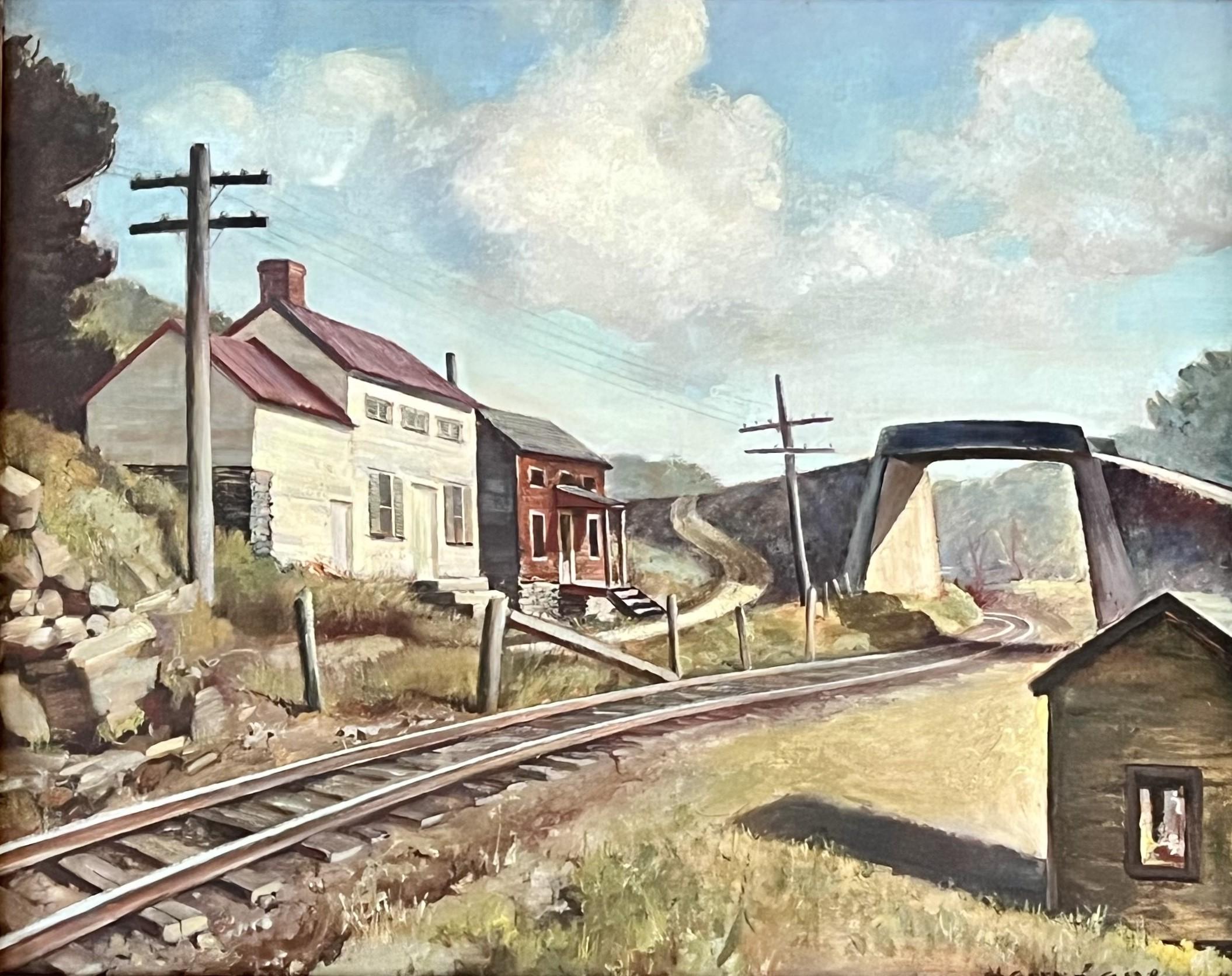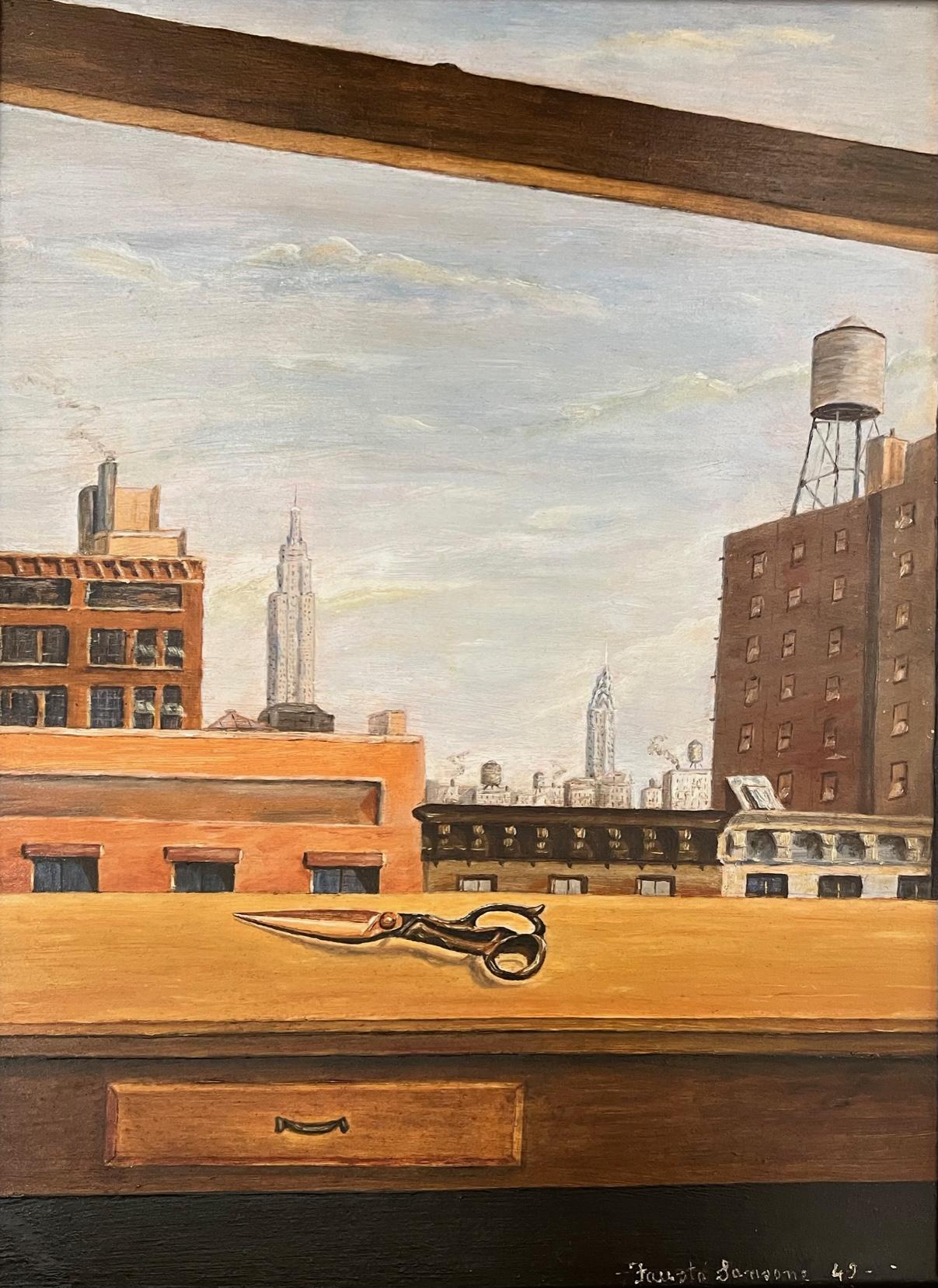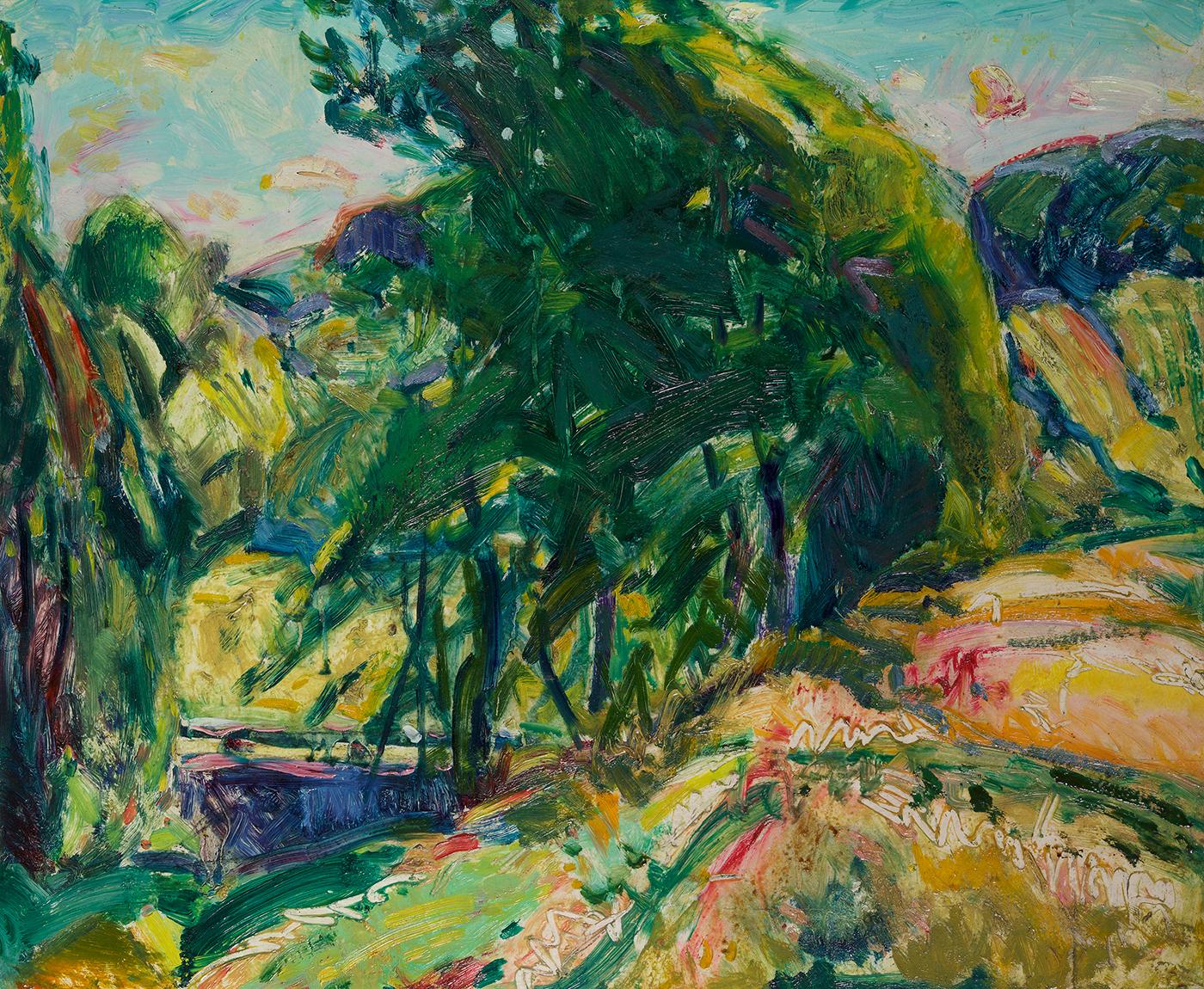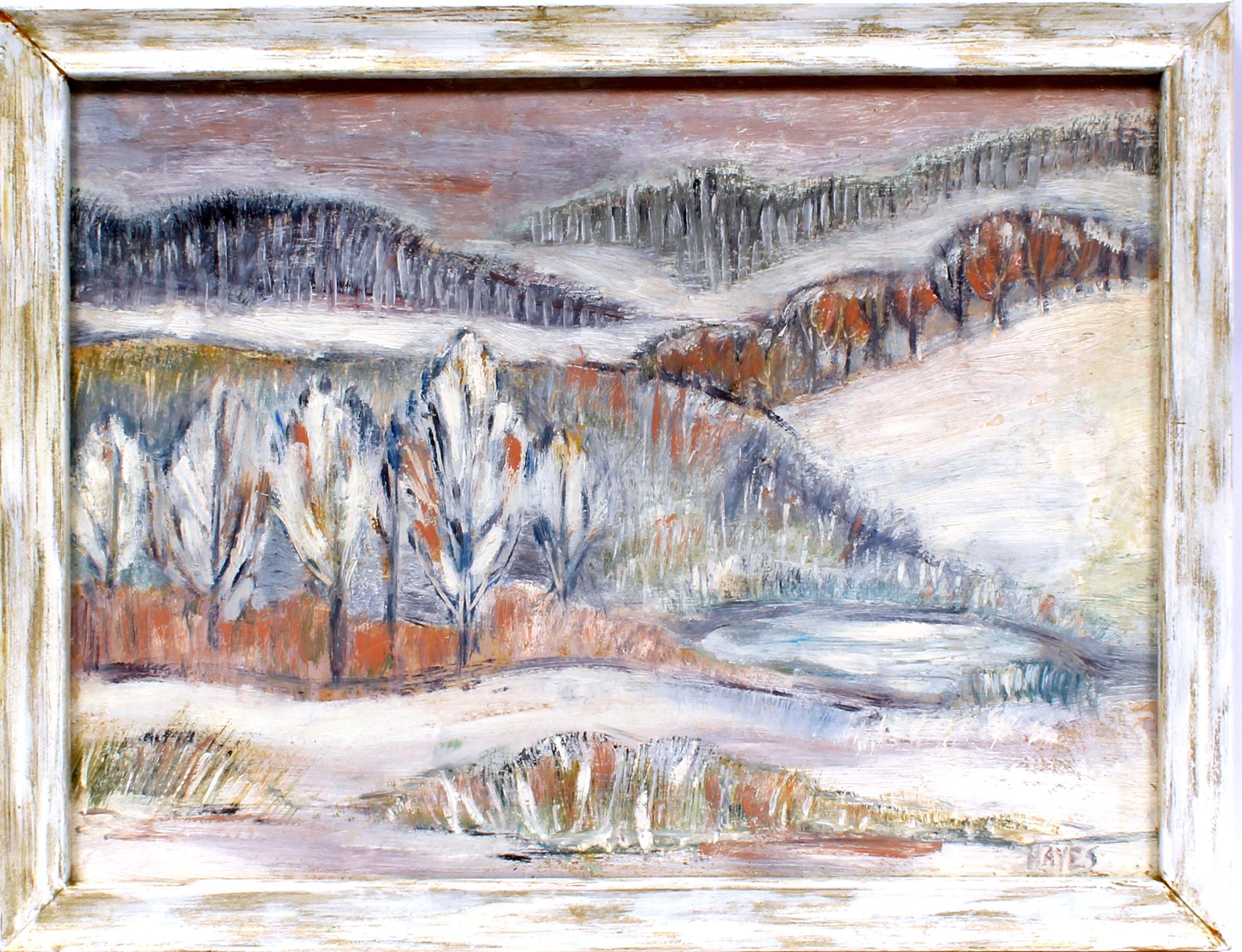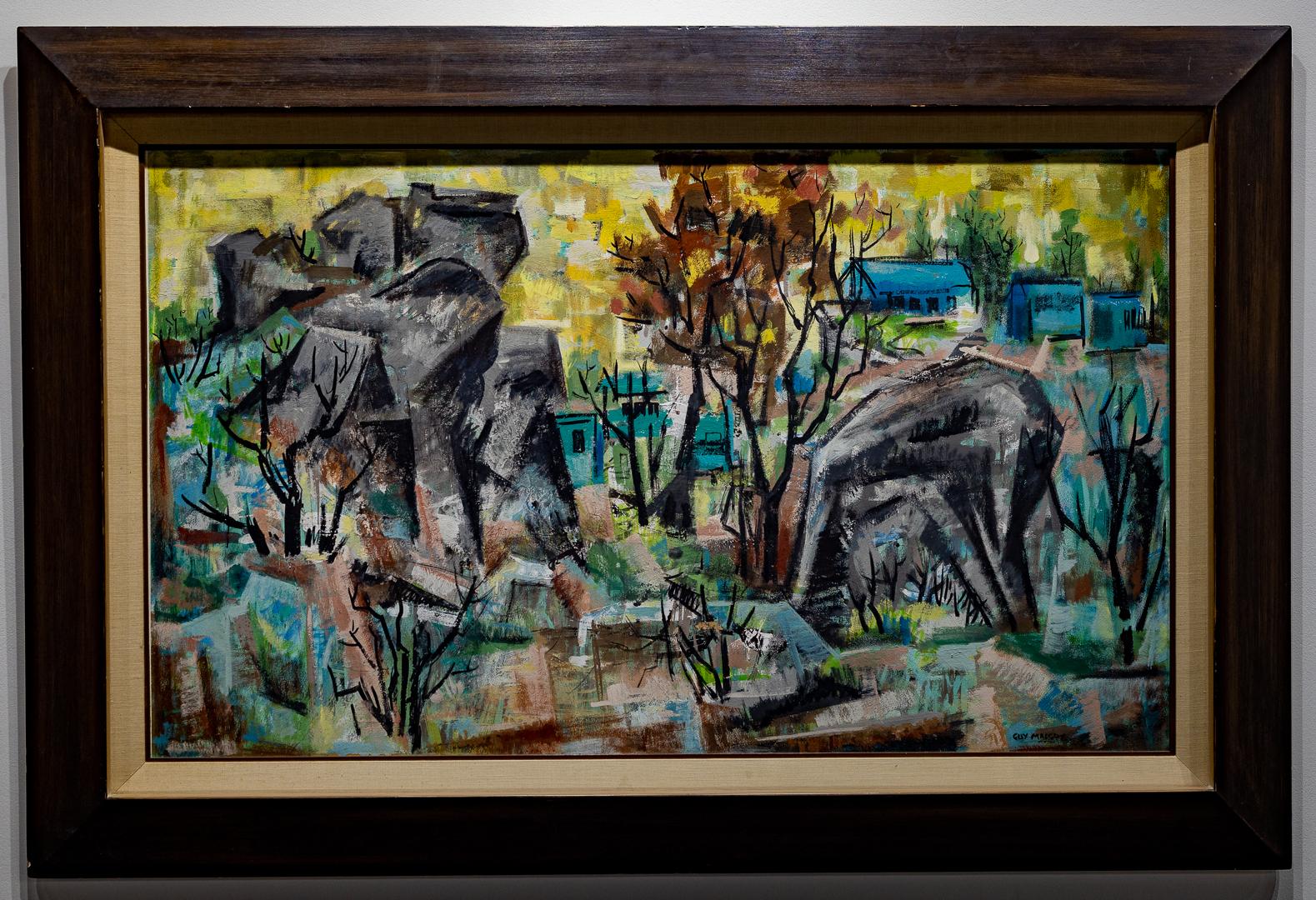Items Similar to Pueblo Near Santa Fe, New Mexico, 1930s Southwestern Landscape Oil Painting
Video Loading
Want more images or videos?
Request additional images or videos from the seller
1 of 17
Eliot Candee ClarkPueblo Near Santa Fe, New Mexico, 1930s Southwestern Landscape Oil Painting1932
1932
About the Item
Oil on board landscape painting of a Pueblo near Santa Fe, New Mexico signed by artist Eliot Candee Clark (1883-1980), painted in 1932. Signed by the artist in the lower left corner. Composed of shades of brown, tan, and blue. Presented in a custom frame, outer dimensions measure 23 ½ x 25 x 1 3⁄4 inches. Image size is 17 1⁄4 x 19 1⁄2 inches.
About the Artist:
Son of landscape painter Walter Clark and Jennifer Woodruff Clark, a student of psychic phenomena, Eliot Clark was a precocious artist who became a landscape painter in the late American Impressionist style. Moving to Albemarle, Virginia in 1932, he was one of the few Impressionist artists of the Southern states. Likely this was a result of his association with James Whistler and his painting in 1900 at Gloucester, Massachusetts with John Twachtman, a family friend. Showing his obvious interest in Impressionism, he wrote a book about its exponents including Twachtman, Theodore Robinson, Childe Hassam, Julian Weir, and Robert Vonnoh.
Clark was a teacher including at the National Art Club from 1943, the Art Students League, and New York City College.
Early in his youth, Clark traveled with his father and other prominent artists to paint in the summer art colonies at Annisquam, Gloucester, Chadd's Ford and Ogunquit where he met artists of stature such as Edward Potthast and John Henry Twachtman. Clark's only formal instruction was a short two months at the Art Students League in New York.
His landscapes evoked a "spiritualized rendition of nature" that was to stay with him for the rest of his life. Clark (perhaps related to his mother's interest in physic phenomena) developed an early interest in oriental philosophy that ended up having a major effect on his artistic development, the sense of spirituality in his landscape paintings slowly grew in importance.
Clark was educated in the New York public schools, and at age 13 exhibited with the National Academy and the New York Water Color Club. By 1912, he had won national painting awards, and by 1916 was writing books on American artists as well as the history of the National Academy. In his early years Clark was privately tutored, and then later graduated from Washington Irving High School at the early age of fifteen. Although he later was quoted as saying "he had no formal training from his father", his early work was notable influenced by Walter Clark's tonalist style.
Between 1904 and 1906, Clark studied in France in Paris and Giverny, and in London he saw the impressionist work of James Whistler. He wrote to his father about the Whistler Exhibit stating that some of Whistler's work impressed him, "not so much in the handling, but in the use of
color, and subtle arrangement of line and balance of masses." He engaged in a "walking tour" of Europe with a fellow artist whom he met in earlier in Paris. They visited many of the major galleries in Holland and then traveled through the Alps, finally reaching Venice on August 10, 1906. I n Venice, he produced some Whistlerian style pastels similar to the ones he had seen in the Whistler Exhibition.
He returned to New York in 1906, and a year later took a studio in the Van Dyke Studio Building on Eighth Avenue. There working in the building were a diversified group of painters such as the tonalist artists Bruce Crane and Cullan Yates; the impressionists were represented by Edward Dufner and Karl Anderson.
In 1912, he painted at the Grand Canyon, in New Mexico, the Painted Desert and northern Arizona, and in 1913, he was in California, painting in Yosemite.
In the 1920s and 1930s, he again painted landscapes in the Southwest including the Arizona Painted Desert in 1926 and 1935. From 1922 to 1932, he lived primarily in Kent, Connecticut along the Housatonic river with such notable impressionist painters as Robert Nesbet and G. Glenn Newell. In 1932, he moved to Albemarle County Virginia to escape from a bitter divorce with his first wife. This led to a dark time for Clark who opted to travel abroad to find himself again rather than take the security of a teaching position, which was offered to him by the University of Georgia.
Because of his interest in eastern philosophy he traveled in the late 1930s to India for two years where he painted the Himalayas and also to Tibet. He also painted in the Deep South in Charleston and Savannah where he set up his easel on the waterfronts and among oak groves. In 1944 rejuvenated by a second marriage and election to the National Academy of Design, Clark returned to the Connecticut countryside to paint landscapes. In the late 1940s Clark began to summer in Virginia where he ultimately returned for good in 1959, settling with his new wife in the "lovely hills" near Albemarle, Virginia.
He continued to paint almost to the end of his life, enjoying the solitude and peace of the surrounding environment where he could relate to canvas the subtleties of nature as only he could. He was elected an associate member of the National Academy of Design in 1917 and full academician in 1944. Clark was also president of the National Academy from 1956-1959. He was a member/president of the American Watercolor Society; president/member of Allied Artists of America, 1948-52; ex officio trustee, Metropolitan Museum of Art, 1956; National Academy of Design Awards Jury; Society of Painters of New York; Connecticut Association of Fine Art; Salmagundi Club; International Society of Arts and Letters; Macdonald Club; Art Fund Society; New York Watercolor Club and others.
Clark exhibited at the New York Watercolor Club; National Academy of Design; American Art Association of Paris Annual Exhibition; Doll & Richards, Boston; Louis Katz Gallery, NY; Guild of Allied Artists, NY; Milwaukee Art Institute; Henry Reinhardt & Son, NY; Mohr Art Galleries; Butler Art Institute; Telfair Academy, Georgia; Rochester Art Association, Rochester, MN; J.W. Young Galleries; Atlanta Woman's Club; Fort Worth Museum of Art, Texas; Carnegie Public Library; Providence Art Club; Witt Memorial Museum, Texas; Nan Sheets Gallery, Oklahoma; Iran Institute and others.He taught at the Art Students'League; Savannah Art club; University of Virginia; Grand Central Art Gallery School and others.
Eliot Candee Clark passed away in 1980.
- Creator:Eliot Candee Clark (1883 - 1980)
- Creation Year:1932
- Dimensions:Height: 23.5 in (59.69 cm)Width: 25 in (63.5 cm)Depth: 1.75 in (4.45 cm)
- Medium:
- Movement & Style:
- Period:
- Framing:Frame IncludedFraming Options Available
- Condition:very good to excellent condition.
- Gallery Location:Denver, CO
- Reference Number:
About the Seller
5.0
Platinum Seller
These expertly vetted sellers are 1stDibs' most experienced sellers and are rated highest by our customers.
Established in 1979
1stDibs seller since 2013
265 sales on 1stDibs
Typical response time: 3 hours
- ShippingRetrieving quote...Ships From: Denver, CO
- Return PolicyA return for this item may be initiated within 7 days of delivery.
More From This SellerView All
- Mexico, 20th Century Landscape with Mountains and Village, Framed Oil PaintingBy Alfred WandsLocated in Denver, COOil on board painting by Alfred James Wands (1904-1998) titled "Mexico". Mountain landscape painting with village of buildings and a church in the foreground painted in colors of gre...Category
Mid-20th Century American Modern Landscape Paintings
MaterialsOil, Board
- In Soquel, California, 1950s Farm Landscape with Silo, Blue, Green, Gold, GrayBy Jon BlanchetteLocated in Denver, CO"In Soquel (California)" is an original oil on board painting by Jon Blanchette (1908-1987) circa 1955. Farm landscape with figure hanging laundry and silo, painted in colors of blue...Category
1950s American Modern Landscape Paintings
MaterialsBoard, Oil
- Near Watsonville, California, Mid Century Landscape Oil Painting House TreesBy Jon BlanchetteLocated in Denver, COMid 20th Century oil on artist board of a white house near Watsonville, California. 1950s landscape painting with house and trees. Presented in a...Category
Mid-20th Century American Modern Landscape Paintings
MaterialsBoard, Oil
- Storm Over Victor (Colorado Mountain Town), 1940s WPA Era Landscape Oil PaintingLocated in Denver, COOil on board painting by George Vander Sluis (1915-1984) titled Storm Over Victor (Colorado Mountain Town) from 1946. WPA Era Mountain Landscape wi...Category
1940s American Modern Landscape Paintings
MaterialsBoard, Oil
- Mid Century Modern Abstracted Cityscape Oil Painting, American Modern, Red BlackLocated in Denver, COMid 20th century oil and spackle painting featuring an abstracted cityscape with a bridge and buildings by Henriette "Yetti" Stolz. Signed by the artist in the lower right margin. Pa...Category
Mid-20th Century American Modern Abstract Paintings
MaterialsOil, Board, Putty
- Southwestern Landscape Painting, Lightning Storm over Mountains, Semi AbstractLocated in Denver, COOriginal vintage painting of a Lightning Storm, Southwestern Mountain Landcape. Oil painting on textured board by Morton Lawrence Schneider (1919-2000). This large scale semi abstrac...Category
20th Century American Modern Landscape Paintings
MaterialsOil, Board
You May Also Like
- Untitled (Houses and Railroad Tracks)By Harry LaneLocated in Los Angeles, CAUntitled (Houses and Railroad Tracks), c. 1940s, oil on canvas board, signed lower right, 16 x 20 inches, presented in a newer frame This work is part of our exhibition America Coas...Category
1940s American Modern Paintings
MaterialsOil, Board
- My Only Working ToolLocated in Los Angeles, CAMy Only Working Tool, 1949, oil on panel, signed and dated lower right, 16 x 12 inches, remnant of exhibition label verso, exhibited at the Art News Second Annual National Amateur Co...Category
1940s American Modern Paintings
MaterialsOil, Board
- Landscape with Green TreeBy Alfred Henry MaurerLocated in New York, NYAlfred Henry Maurer has been called the First American Modern because of his role in bringing modern methods of working to the United StatesCategory
Early 20th Century American Modern Landscape Paintings
MaterialsOil, Board
- Vintage Female Modernist Landscape "Berkshire Hills" 1961Located in Buffalo, NYVintage modernist landscape signed Nannette Rhodes Hayes. Titled on the reverse Berkshire Hills and dated 1961.Category
1960s American Modern Landscape Paintings
MaterialsBoard, Oil
- Guy Maccoy "City Beyond the Bluffs" Cityscape Oil on Board MCMLocated in Detroit, MISALE ONE WEEK ONLY "City Beyond the Bluffs" is a colorful dynamic example of Maccoy's Mid-20th century paintings. Considered Mid-Century Modern it also has Cubist style in the bluffs. Unframed the piece measures 25 x 42. Guy Crittington McKay was born to Clifford McKay and Clara Angeline Young who was the granddaughter of Brigham Young. Clifford McKay later changed the family name to McCoy. Later on Guy changed his name to Maccoy. Guy Maccoy...Category
Mid-20th Century American Modern Landscape Paintings
MaterialsOil, Board
- Large Modernist Oil Painting 1940s, Judaica Hasidic Shtetl Wagon Driver WPA EraBy Emanuel Glicenstein RomanoLocated in Surfside, FLGenre: Modern Subject: Landscape with figure of horse, driver and wagon Medium: Oil Surface: wood Board EMANUEL ROMANO Rome, Italy, b. 1897, d. 1984 Emanuel Glicen Romano was born in Rome, September 23, 1897. His father Henryk Glicenstein was a sculptor and was living in Rome with his wife Helena (born Hirszenberg) when Emanuel was born. His father obtained Italian citizenship and adopted the name Enrico. Emanuel was brought up in Italy, Switzerland, Germany, England and Poland. In 1926 Emanuel Glicenstein Romano and his father sailed for New York. They briefly visited Chicago. Romano's sister, Beatrice, and mother only joined them in New York years later. Romano changed his name on his arrival to America and some have erroneously speculated that this was to avoid antisemitic discrimination. In truth, as the son of a highly-regarded artist, Romano changed his name to ensure that any success or recognition he would later attain, would be the result of nothing other than his own merit as an artist, and not on account of his father's fame. In 1936 Romano was worked for the WPA Federal Art Project creating murals. ( there were many jewish artists active with in the WPA period. notably Chaim Gross, Ben Shahn, Isaac and Moses Soyer, Abraham Rattner and many others. During and immediately after World War II, Romano created a series of allegorical works depicting graphic holocaust images that were held closely by the family until after his passing. One of these works is now on permanent display in the Florida Holocaust Museum in St. Petersburg Florida. Emanuel's father died in 1942 in a car accident before they could realize their shared dream of visiting Israel. In 1944 Romano, having completed his degree at the Pennsylvania Academy of Fine Arts and the Art Institute of Chicago, began teaching at the City College of New York. Romano moved to Safed, Israel in 1953 and established an art museum in his father's memory, the Glicenstein Museum. COLLECTIONS Indianapolis Museum of Art Metropolitan Museum of Art Boston Fine Arts Museum Fogg Museum Musée Nacional de France Recently his work has been added to the Florida Holocaust Museum collection. His notable works include his holocaust themed allegorical paintings as well as portraits of Marianne Moore, his father and William Carlos Williams...Category
1930s American Modern Figurative Paintings
MaterialsOil, Board
Recently Viewed
View AllMore Ways To Browse
New Mexico Landscape Painting
Grand New York Paintings
Oil Canvas Mexico
Mexican Oil Canvas Painting
Connecticut Landscape Painting
Worth New York
Santa Fe New Mexico
Santa Fe Art Galleries
Santa Fe Gallery
New Mexico Landscape Oil
New Mexico Landscape Oil Paintings
New York City 1920s
Desert New Mexico
Mexico Oil Painters
Landscape Oil Boston
South American Landscape Paintings
Boston Landscape Oil Painting
Mexico Travel
